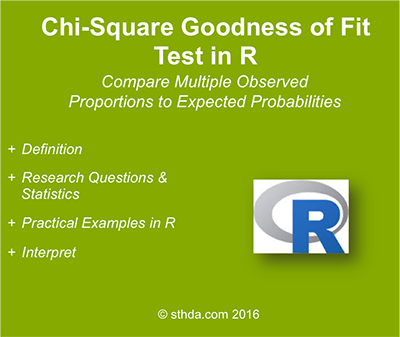Chi-square Goodness of Fit Test in R
What is chi-square goodness of fit test?

Example data and questions
For example, we collected wild tulips and found that 81 were red, 50 were yellow and 27 were white.
- Question 1:
Are these colors equally common?
If these colors were equally distributed, the expected proportion would be 1/3 for each of the color.
- Question 2:
Suppose that, in the region where you collected the data, the ratio of red, yellow and white tulip is 3:2:1 (3+2+1 = 6). This means that the expected proportion is:
- 3/6 (= 1/2) for red
- 2/6 ( = 1/3) for yellow
- 1/6 for white
We want to know, if there is any significant difference between the observed proportions and the expected proportions.
Statistical hypotheses
- Null hypothesis (\(H_0\)): There is no significant difference between the observed and the expected value.
- Alternative hypothesis (\(H_a\)): There is a significant difference between the observed and the expected value.
R function: chisq.test()
The R function chisq.test() can be used as follow:
chisq.test(x, p)- x: a numeric vector
- p: a vector of probabilities of the same length of x.
Answer to Q1: Are the colors equally common?
tulip <- c(81, 50, 27)
res <- chisq.test(tulip, p = c(1/3, 1/3, 1/3))
res
Chi-squared test for given probabilities
data: tulip
X-squared = 27.886, df = 2, p-value = 8.803e-07The p-value of the test is 8.80310^{-7}, which is less than the significance level alpha = 0.05. We can conclude that the colors are significantly not commonly distributed with a p-value = 8.80310^{-7}.
Note that, the chi-square test should be used only when all calculated expected values are greater than 5.
# Access to the expected values
res$expected[1] 52.66667 52.66667 52.66667Answer to Q2 comparing observed to expected proportions
tulip <- c(81, 50, 27)
res <- chisq.test(tulip, p = c(1/2, 1/3, 1/6))
res
Chi-squared test for given probabilities
data: tulip
X-squared = 0.20253, df = 2, p-value = 0.9037The p-value of the test is 0.9037, which is greater than the significance level alpha = 0.05. We can conclude that the observed proportions are not significantly different from the expected proportions.
Access to the values returned by chisq.test() function
The result of chisq.test() function is a list containing the following components:
- statistic: the value the chi-squared test statistic.
- parameter: the degrees of freedom
- p.value: the p-value of the test
- observed: the observed count
- expected: the expected count
The format of the R code to use for getting these values is as follow:
# printing the p-value
res$p.value[1] 0.9036928# printing the mean
res$estimateNULLSee also
Infos
This analysis has been performed using R software (ver. 3.2.4).
Show me some love with the like buttons below... Thank you and please don't forget to share and comment below!!
Montrez-moi un peu d'amour avec les like ci-dessous ... Merci et n'oubliez pas, s'il vous plaît, de partager et de commenter ci-dessous!
Recommended for You!
Recommended for you
This section contains best data science and self-development resources to help you on your path.
Coursera - Online Courses and Specialization
Data science
- Course: Machine Learning: Master the Fundamentals by Standford
- Specialization: Data Science by Johns Hopkins University
- Specialization: Python for Everybody by University of Michigan
- Courses: Build Skills for a Top Job in any Industry by Coursera
- Specialization: Master Machine Learning Fundamentals by University of Washington
- Specialization: Statistics with R by Duke University
- Specialization: Software Development in R by Johns Hopkins University
- Specialization: Genomic Data Science by Johns Hopkins University
Popular Courses Launched in 2020
- Google IT Automation with Python by Google
- AI for Medicine by deeplearning.ai
- Epidemiology in Public Health Practice by Johns Hopkins University
- AWS Fundamentals by Amazon Web Services
Trending Courses
- The Science of Well-Being by Yale University
- Google IT Support Professional by Google
- Python for Everybody by University of Michigan
- IBM Data Science Professional Certificate by IBM
- Business Foundations by University of Pennsylvania
- Introduction to Psychology by Yale University
- Excel Skills for Business by Macquarie University
- Psychological First Aid by Johns Hopkins University
- Graphic Design by Cal Arts
Books - Data Science
Our Books
- Practical Guide to Cluster Analysis in R by A. Kassambara (Datanovia)
- Practical Guide To Principal Component Methods in R by A. Kassambara (Datanovia)
- Machine Learning Essentials: Practical Guide in R by A. Kassambara (Datanovia)
- R Graphics Essentials for Great Data Visualization by A. Kassambara (Datanovia)
- GGPlot2 Essentials for Great Data Visualization in R by A. Kassambara (Datanovia)
- Network Analysis and Visualization in R by A. Kassambara (Datanovia)
- Practical Statistics in R for Comparing Groups: Numerical Variables by A. Kassambara (Datanovia)
- Inter-Rater Reliability Essentials: Practical Guide in R by A. Kassambara (Datanovia)
Others
- R for Data Science: Import, Tidy, Transform, Visualize, and Model Data by Hadley Wickham & Garrett Grolemund
- Hands-On Machine Learning with Scikit-Learn, Keras, and TensorFlow: Concepts, Tools, and Techniques to Build Intelligent Systems by Aurelien Géron
- Practical Statistics for Data Scientists: 50 Essential Concepts by Peter Bruce & Andrew Bruce
- Hands-On Programming with R: Write Your Own Functions And Simulations by Garrett Grolemund & Hadley Wickham
- An Introduction to Statistical Learning: with Applications in R by Gareth James et al.
- Deep Learning with R by François Chollet & J.J. Allaire
- Deep Learning with Python by François Chollet







